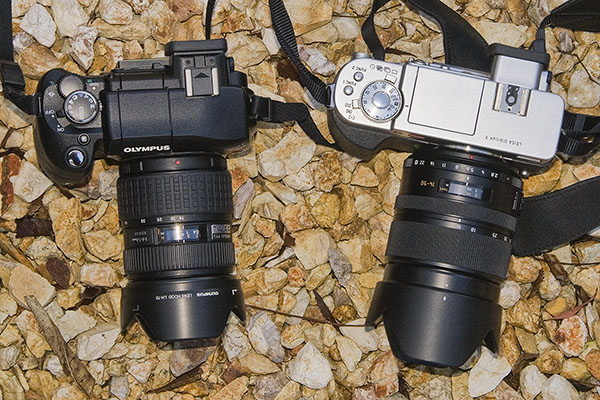3/5/2007 Note: Olympus announced
the new E-510 camera which features image stabilization on the
sensor level.
Recently we had two Four Thirds cameras for
test. What is a Four Thirds camera? Olympus influenced (created)
a industry consortium to standardize cameras for a new lens
mount and sensor size. The proclaimed goal was to initiate cameras
that can use lenses only designed for digital cameras.
Up until recently only Olympus produced cameras and
lenses for the Four Thirds system. Then Sigma was the first third party
company that produced lenses for the Four Thirds system. Likely the
most important
news for the Four Thirds system is that Panasonic (with Leica lenses)
is producing its own Four Thirds cameras and using Leica zooms on it.
Different
to
Sony (buying Minolta) and Samsung (OEM Pentax cameras) Panasonic uses
a more open lens mount standard. Hard to tell whether this will allow
the Four Thirds system to be a broader success in the future. The key
questions we see are:
- How will future Panasonic and Kodak sensors
compare to the ones by Sony and Canon?
- Is the Four Thirds sensor size ("The standard diagonal length is
21.63 mm (half that of 35-mm film format)" a limit for higher demand
on resolution?
- Will Fuji and Kodak (both members of the Four Thirds consortium)
also develop own Four Thirds cameras. We don't think Kodak will do
this.

Olympus E330 and Leica Digilux 3
Here are some notes on two Four Thirds
cameras launched in 2006:
- Leica Digilux 3 (Panasonic Lumix DMC-L1)
- Olympus E330
Leica Digilux 3 and Olympus E330
We think of the Leica Digilux 3 mainly
as a Panasonic camera from the body part and of course with
a Leica zoom lens.
Panasonic licensed quite a few features
from Olympus to build this new body:
-
Viewfinder
- Anti dust technology (first introduced to digital SLRs by Olympus
and now followed by many other companies: even by Canon in the new
400D/Rebel XTi)
- Four Thirds lens mount
In return Panasonic licensed it's new Live MOS sensors
(more
info from Panasonic) to Olympus for the E330.
This is by no means a review. We try to communicate some of our
observations while handling both cameras.
Overall we liked both cameras but we are not sure how much of an alternative
these cameras are compared to Canon's and Nikon's offerings. For sure
the Leica zoom seems attractive and the Olympus lenses are also good
performers. Hard to say how bright the future for Four Thirds cameras
will be.
- We expect new Leica lenses shown at PMA 2007
- Also Olympus should get closer to their next flagship camera after
the E-1
Here are some RAW files from both cameras.
For a reference there are also two shots with a Canon 5D and the extreme
sharp Canon 50mm f/1.2 .
|